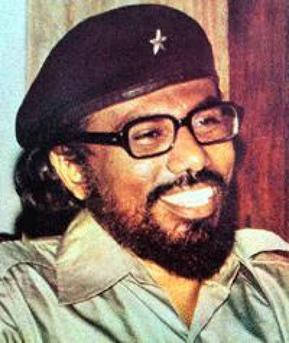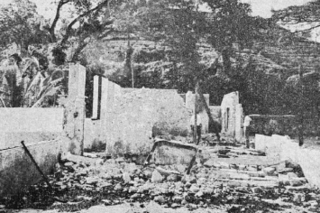
The Janatha Vimukthi Peramuna is a leftist political party in Sri Lanka. The party was formerly a revolutionary movement and was involved in two armed uprisings against the government of Sri Lanka: once in 1971 (SLFP), and another in 1987–1989 (UNP). The motive for both uprisings was to establish a socialist state. Since then the JVP has entered mainstream democratic politics and has updated its ideology, abandoning some of its original Marxist policies such as the abolition of private property. The JVP has been led by President Anura Kumara Dissanayake since 2014.

Patabendi Don Jinadasa Nandasiri Wijeweera, better known as Rohana Wijeweera, was a Sri Lankan Marxist–Leninist political activist, revolutionary, and founder of the Janatha Vimukthi Peramuna. Wijeweera led the party in two unsuccessful insurrections in Sri Lanka, in 1971 and 1987 until his assassination.

The 1971 Janatha Vimukthi Peramuna (JVP) insurrection was the first of two unsuccessful armed revolts conducted by the communist Janatha Vimukthi Peramuna (JVP) against the socialist United Front Government of Sri Lanka under Prime Minister Sirimavo Bandaranaike. The revolt began on 5 April 1971 and lasted until June of that year. The insurgents held towns and rural areas for several weeks, until the regions were recaptured by the armed forces, following strong support from friendly nations that sent men and material. Although this first attempt to seize power was quickly crushed by force, in 1987 the JVP launched a low-intensity insurgency in the island's southern, central and western regions that lasted several years.

The 1987–1989 JVP insurrection, also known as the 1988–1989 revolt or the JVP troubles, was an armed revolt in Sri Lanka, led by the Marxist–Leninist Janatha Vimukthi Peramuna, against the Government of Sri Lanka. The insurrection, like the previous one in 1971, was unsuccessful. The main phase of the insurrection was a low-intensity conflict that lasted from April 1987 to December 1989. The insurgents led by the JVP resorted to subversion, assassinations, raids, and attacks on military and civilian targets while the Sri Lankan government reacted through counter-insurgency operations to suppress the revolt.

Sri Lanka Police is the civilian national police force of the Democratic Socialist Republic of Sri Lanka. The police force is responsible for enforcing criminal and traffic law, enhancing public safety, maintaining order and keeping the peace throughout Sri Lanka. The police force consists of 43 Territorial Divisions, 67 Functional Divisions, 432 Police Stations with more than 84,000 people. The professional head of the police is the Inspector General of Police who reports to the Minister of Law and Order as well as the National Police Commission. The last Inspector General of Police was Deshabandu Tennakoon.

Major General Janaka Perera, RWP, RSP, VSV, USP, VSP was a Sri Lankan General and politician. He served as the Chief of Staff of the Sri Lanka Army and is considered one of the most distinguished generals in Sri Lankan history. After retiring from the army he served as a Sri Lankan High Commissioner to Australia and Ambassador to Indonesia. He was the opposition leader of the North Central Provincial Council until he and his wife were killed on 6 October 2008 by a suicide bomber. The LTTE have been blamed for the bombing by Sri Lankan president Mahinda Rajapaksa.
The 1962 Ceylonese coup d'état attempt was a failed military coup d'état planned in Ceylon. A group of Christian officers in the military and police planned to topple the government of Prime Minister Sirimavo Bandaranaike during the night of 27 January 1962. Organised by Colonel F. C. de Saram, Colonel Maurice De Mel,, Rear Admiral Royce de Mel, C.C. Dissanayake, Sydney de Zoysa and Douglas Liyanage, it was to take place in the night of 27 January 1962, but was called off as the government gained information in the afternoon and initiated arrests of the suspected coup leaders before the coup was carried out.

The Sri Lanka Armed Forces is the overall unified military of the Democratic Socialist Republic of Sri Lanka encompassing the Sri Lanka Army, the Sri Lanka Navy, and the Sri Lanka Air Force; they are governed by the Ministry of Defence (MoD). The three services have around 346,700 active personnel; conscription has never been imposed in Sri Lanka. As of 2021 it is the 14th largest military in the world, with 1.46% of the Sri Lankan population actively serving.

The history of Sri Lanka from 1948 to the present is marked by the independence of the country through to Dominion and becoming a Republic.
Sellapperumage Saman Piyasiri Fernando, was the military wing leader of the Janatha Vimukthi Peramuna during the 1987-89 insurrection in Sri Lanka, the JVP's military wing also known as Deshapremi Janatha Viyaparaya (DJV). His position in the JVP as the military commander was organizationally higher than the position of Rohana Wijeweera, the founder of the JVP.
The 1966 alleged Ceylonese coup d'état attempt was an alleged military coup planned in Sri Lanka (Ceylon). The commander of the army and several military personnel were arrested. They were later acquitted of a plot to overthrow the legally elected government.

Deshapremi Janatha Vyaparaya was a militant organisation in Sri Lanka. It was widely considered to be the military branch of the Marxist–Leninist Janatha Vimukthi Peramuna and had been designated as a terrorist organisation by the Sri Lankan government.

Don Upatissa Gamanayake, also known by his alias Dias Mudalali, was a Sri Lankan politician and the deputy leader of the Jantha Vimukthi Peramuna (JVP) during the 1987–1989 insurrection. Not a prominent figure during the JVP's 1971 insurrection, Gamanayake emerged as a leader only after the releasing of the JVP detainees in 1977. He moved up rapidly in the party hierarchy during the JVP's 1977–1983 democratic phase and became the second in command after the founder and the leader, Rohana Wijeweera. He unsuccessfully contested the 1983 Anamaduwa by-election under JVP. Gamanayake was captured and killed by the government forces in November 1989.
General Lionel Piyananda Balagalle,, was a senior Sri Lanka Army officer, who served as the Commander of the Sri Lanka Army and the Chief of the Defence Staff. He is known for formalising military intelligence operations within the Sri Lanka Army, having founded the Directorate of Military Intelligence and the Military Intelligence Corps.

General L. D. E. Cecil Waidyaratne, VSV, USP was a Sri Lanka Army general. He was 12th Commander of the Sri Lankan Army and a former Sri Lankan Ambassador to Thailand.
Terrorism in Sri Lanka has been a highly destructive phenomenon during the 20th and 21st centuries, especially so during the periods of the Sri Lankan Civil War (1983–2009) and the first (1971) and second JVP insurrections (1987–1989). A common definition of terrorism is the systematic or threatened use of violence to intimidate a population or government for political, religious, or ideological goals. Sri Lanka is a country that has experienced some of the worst known acts of modern terrorism, such as suicide bombings, massacres of civilians and assassination of political and social leaders. Terrorism has posed a significant threat to the society, economy and development of the country. The Prevention of Terrorism Act of 1978 is the legislation that provides the powers to law enforcement officers to deal with issues related to terrorism in Sri Lanka. It was first enacted as a temporary law in 1979 under the presidency of J. R. Jayewardene, and later made permanent in 1982.
John Wilhelmus Lucius Attygalle (1906–1981) was the 16th Inspector General of the Sri Lanka Police (IGP) (1966–1967).
The Criminal Justice Commission (CJC) were established by the Criminal Justice Commission Act No 14 of 1972, to serve as both a public inquiry and a tribunal to pass sentence. The key aspect of the CJC was that it could accept evidence that would have otherwise be inadmissible under the Evidence Ordinance which governs evidence applicable in court, the shift of burden of proof on the accused and the finding or sentence of the tribunal becoming final and would not be appeal-able. Two Criminal Justice Commissions were formed, the first in 1972 to try the perpetrators of the 1971 JVP insurrection and the second in 1975 to prosecute exchange control offences. The CJC was a controversial legislation and was repealed in 1977 under the Criminal Justice Commissions (Repeal) Law, No. 12 of 1977. General amnesty was issued to all convicted under the two commissions.
Communism in Sri Lanka dates back to 1935, when the Lanka Sama Samaja Party was founded by Trotskyists who campaigned for freedom and independence of Sri Lanka which was then a colony of the British Empire and known as Ceylon.

Vijaya Kumaratunga, Sri Lankan politician and founder of the Sri Lanka Mahajana Pakshaya, was assassinated by an assassin of the militant organization Deshapremi Janatha Viyaparaya (DJV) on February 16, 1988, while attempting to leave his home in Polhengoda in Colombo.











